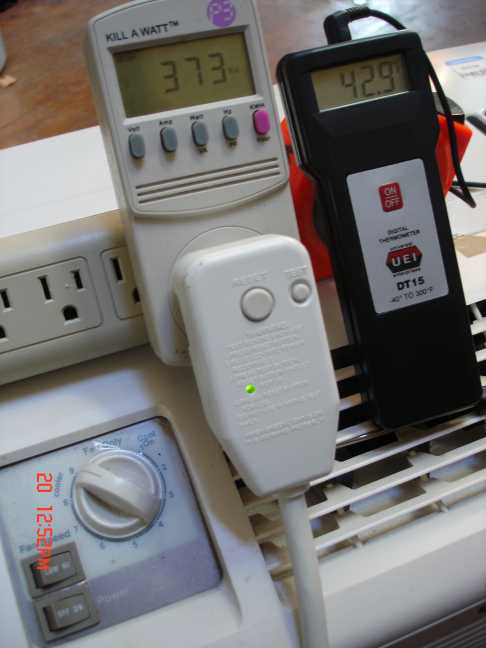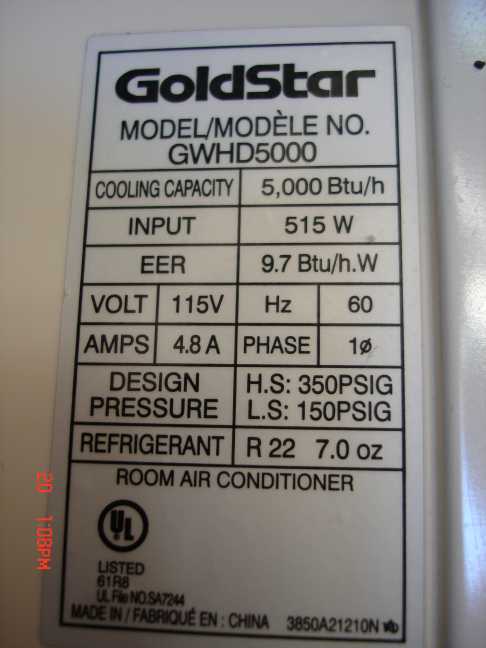So if the thread is called "how to make a heat pump out of junk", I guess one of the first secrets is how to tell that the hardware you have is not really junk after all.
In this section, I'm going to describe finding an Air Conditioner Unit as a candidate for re-purposing. De-Humidifiers also make good candidates, maybe even better, but there are many more AC units in Goodwill, junk stores and garage sales.
Although you can get by without one, a device that will measure watts in realtime can be a very useful tool, not only for selecting but also for subsequent testing and evaluation. I use a model called a Kill-A-Watt link here: [
http://www.p3international.com/produ...P4400-CE.html]. I actually have two and I use them all the time.
The popular misconception about non-functioning or poorly functioning AC units it that "the refrigerant leaked out". Compared to other problems, this is actually pretty unusual. The most common problem is that the coils have become blocked by debris.
So first, we need to run it.
Plug the unit in. If you have one, plug the unit in to a watt meter and the watt meter into an outlet.
Turn the unit to 'fan only' or 'cool off' or what ever it takes to just run the fan. Let it run and note the reading on the watt meter. It should be somewhere in the 30 to 80 watt range. If it is drawing more than 80 watts, then compressor is on. Turn off the compressor. Let the unit run for five minutes and feel (or measure) the air coming out. This will be our baseline temperature.
 AC_fan-only
AC_fan-only
After five minutes or so, turn the unit to Maximum cool and the fan to high. Let it run for 5 to 10 minutes.
CASE #1 - Watt meter reads 300 to 1500 watts, the unit is blowing copious amounts of cold air out the front (obviously cooler than our baseline temperature). When you feel the rear coils, they should feel a bit warm to the touch.
 AC_fan+compressor
AC_fan+compressor
If this is the case, you obviously have a proven winner.
CASE #2 - Watt meter reads reads between 300 and 1500 watts, the unit is not cooling very well. The rear coils feel warm-to-hot. The front coils feel cold.
Possible causes:
a) Blocked Air Flow - This is very common. The filter in the front or the coils in the front or back of the unit are blocked. This may be why the unit was tossed. If you feel the coils in the front they should feel cold, also if you feel the coils in the back, they should feel warm. If the coils or air-filter are clogged it's simple to fix with a really strong vacuum cleaner, but for our heat pump purposes, you might not use the refrigerant-to-air coils at all. Liquid-to-liquid heat exchangers are much more efficient and open up a very interesting world of experimental possibilities. In the coming posts, I will show you how to buy or make liquid-to-liquid heat exchangers.
b) The refrigerant has leaked. This is actually pretty unusual. If your unit is drawing more than 300 watts, and no cooling is happening, don't consider this unit at all. If refrigerant can get out, water can get in. Water in any amount, in the refrigerant system is bad for heat pumps.
CASE #3 - Watt meter reads 30 to 80 watts during the whole test.
This means your compressor never came on. Possible problems:
a) The compressor is dead. Compressors are well-built, hermetically sealed and tested before they ever leave the factory. This would be very unlikely to be the case.
b) The compressor starting capacitor is dead. The compressor starting cap is pretty darn reliable. This is also an unlikely case.
c) The compressor thermal safety switch has failed. These are reliable, not so likely to fail.
d) The switch on the front of the unit, or it's attached thermal sensor is bad. These can be the problem more likely than the above problems. But if these are the problem, it makes subsequent testing difficult.
e) The temperature where the AC unit is being tested is too low for the cooling cycle to start. This is can be very likely. Most of the units I have looked at need to be warmer than about 65-70 degrees F to begin to work, even at Maximum cool. You may have a winner on your hands...maybe.
So, if you can't verify that the compressor is actually working, it's really a crap-shoot. If you can get the unit for free or really, really cheap ($5), it might be worth it, but no matter how cheap, remember if it doesn't work, you still have to dispose of the carcass. Probably better to keep looking...
Other things to consider:
Look for the refrigeration identification tag. It will tell you some things like:
 AC_the-tag
AC_the-tag
* Cooling capacity - This is a sales figure. It may be accurate, or it may be exaggerated. This was what was found under 'lab conditions', wherever or whatever that is.
* Input - This is about the maximum that the compressor and the fan will draw.
* Refrigerant Pressures - Write this down, you may need this info later.
* Refrigerant Type - This is the refrigerant that the unit was designed to use.
Freon - Usually R-22 & R-12. They worked great except that they destroy the ozone layer and cause global warming. A real problem. These are very expensive to obtain and in some cases illegal if you don't have a HVAC license certificate.
It is interesting to note that German Children seem prefer using Propane (AKA: R-290, Barbecue Gas, etc) because it is not damaging to the ozone layer and has zero global warming potential, and is incredibly cheap, and requires no license to obtain. It also works well with compressors designed for R-12 & R-22, as it uses the same type of lubricant (mineral oil type). It also seems to be similar enough to R-22 that it can be use without significant modification to the metering devices (more on that later). If I understand correctly, R-290 is being used as an automotive refrigerant in Australia. It is very flammable and produces water vapor and carbon dioxide (CO2) in the process.
R-134a - Currently in use. Can be obtained in auto parts store. It does not destroy the ozone layer but does cause global warming. It will be restricted and then phased out. Compressors that use R134a will not be compatible with Freons, as the compressor oil is of a different base and does not play well with mineral oil compressor lubricants or the refrigerants that use these lubricants (R-22 or R-12 and R-290). I have heard of people having success by completely replacing the lubricant with mineral oil compressor lubricant. I have not tried this. Use of this refrigerant is reported to cause cancer of the testicles in lab rats. Under certain conditions, R-134a can burn and produces deadly gasses in the process.
Regarding the size of the compressor, there's a saying that a cowboy can't have too much money, too fast a horse, or too many women. Well, what works for cowboys doesn't really work for heat pumps. if you have a large compressor, you pay more for it with every revolution. The trick is to figure the maximum BTUs or watts you will need, and design a little bit smaller. Plan to use a supplimental energy source to fill in during extreme conditions.
So I have found smaller units to be the most interesting. I have a couple of bigger compressors (about 12,000 BTU) in the cellar for future experiments, but it's the smaller ones that really fascinate me now (small house heating, water pre-heating, high efficiency refrigeration, domestic water heat recovery, etc.)
The AC unit that is in these pictures works perfectly, looks brand new, is the right size and had the fabric filter clogged with cat hair. It cost $25.
So best of luck to you finding a good unit. Let me know what you found and how much it cost...
Remember, don't open the refrigerant system until you're all prepared and ready to braze it back up. We have a way to go yet.
(NEXT POST: We look under the hood to see what's going on...)